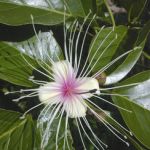| Common Name: |
Barna |
| Other Names: |
Garlic Pear, Three-leafed caper, Varuna |
| Botanical Name: |
Crateva religiosa syn. C nurvala |
| Genus: |
Crateva |
| Family: |
Capparidaceae |
| Native Location: |
Asia to Australia and Pacific Islands. |
| Cultivation: |
Moist, rich, neutral to acid soil in sun or partial shade. |
| Propagation: |
By seed sown when ripe at 18°C (64°F) |
| Harvest: |
Young shoots, leaves and flowers are picked as required and used fresh. Leaves are also dried for infusions. Bark is collected throughout the year and dried for decoctions, or ground into powder. |
| Height: |
15m (50ft) |
| Width: |
9m (30ft) |
| Hardiness: |
Min 15°C (59°F) |
| Parts Used: |
Leaves, shoots, flowers, bark |
| Properties: |
A bitter, pungent herb that has diuretic and rubefacient effects, improves digestion, and prevents and treats formation of stones in the kidney and bladder. |
| Medicinal Uses: |
Internally for urinary tract infections, urinary problems associated with prostate enlargement, kidney and bladder stones, gastritis, poor appetite, fevers (bark); obesity, rheumatism (leaves). Externally for rheumatism (leaves). |
| Culinary Uses: |
Leaves and young shoots are cooked as a vegetable. Flowers are pickled. Berries and seeds are also edible. |
| Bibliography: |
Encyclopedia of Herbs by Deni Brown Copyright © 1995, 2001 Dorling Kindersley Limited. pp 182-183 |

